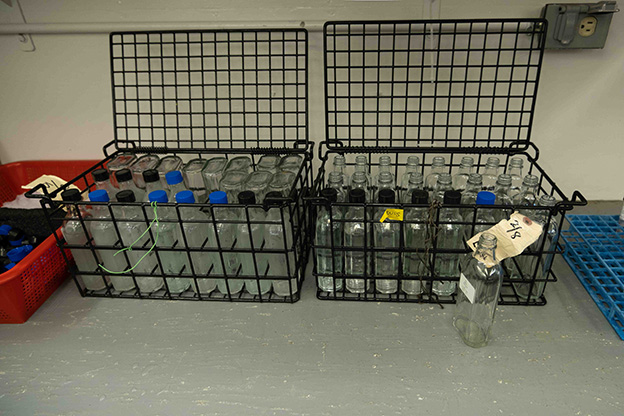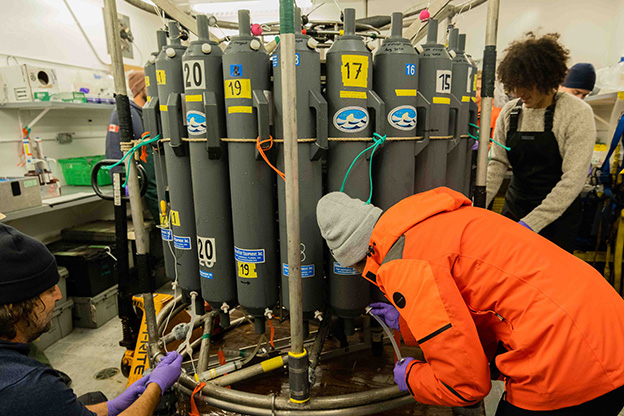Dispatch 3: The First CTD Casts!
Ashley Arroyo and Elizabeth Bailey
September 18, 2022
Last night around 10:00 p.m. EST, we arrived at our first station in Amundsen Gulf, which has historically been the first (or occasionally the last) station for the yearly expedition. In addition, this is a station that has also been sampled by other programs, establishing a long timeseries of valuable data at that location. Since this was our first station of the expedition, it was a perfect time to make sure the oceanographic sensors were operating properly before we start sampling in the Canada Basin. Typically, the station is also used as a training station for the new members of the science team. This year was no different with most of the new members of the science team staying up into the early hours of the morning to complete sampling.
The same (or similar) set of oceanographic station locations are revisited on each annual expedition. One of the main ocean measurements we make at each station uses a CTD. A CTD, or conductivity-temperature-depth, is an instrument that measures seawater temperature, salinity, and the depth through the water column. We have additional sensors that measure oxygen, fluoresce, turbidity, PAR (photosynethically available radiation, i.e., light levels for algae) , chlorophyll, and CDOM (colored dissolved organic matter, i.e., organic matter that gives color to the water). All of these sensors are mounted at the center of a Rosette, which is a large sampling instrument that holds bottles, called Niskin bottles, used to collect water samples at specific depths. Once the CTD/Rosette is in the water and being lowered while taking measurements, there is a CTD operator in a heated “shack” on the deck of the ship, who is responsible for closing the Niskin bottles at pre-determined depths. Once the rosette is back on deck and secured in a heated shelter, the scientists start collecting water samples from each of the bottles! These water samples are taken to labs on the ship (or prepared to be sent off to labs on land at the end of the expedition) for analysis.
At this station, we did two casts of the CTD/Rosette (i.e., we lowered the sensors and bottles to 10 meters above the ocean floor). On the first cast, we collected water samples for microbial DNA analysis, which requires lots of water – 20 liters! The second cast was focused on the geochemistry; a specific order needs to be followed to ensure that certain samples are not contaminated/compromised. First, the dissolved gases (i.e., dissolved oxygen and dissolved inorganic carbon, DIC) must be sampled to avoid exposure to the atmosphere. The next group of samples includes the biological parameters, such as bacteria and FDOM (fluorescent dissolved organic matter), followed by chlorophyll and nutrients. The last samples collected include salinity, barium, and oxygen isotopes. Each of the different samples are collected in different types of containers based on their properties/ how they must be analyzed. For example, the chlorophyll samples are collected in dark brown plastic bottles to ensure that the concentrations do not change from the time of collection, if exposed to sunlight.
What else did we do today? This afternoon, a group of us tried on immersion suits – a suit designed to help us survive for up to an hour in the freezing temperature of the Arctic Ocean, if we ever needed to evacuate from the ship. We rounded out the day with a couple more CTD casts that brought in lots of samples to analyze, which we will jump into next dispatch!





